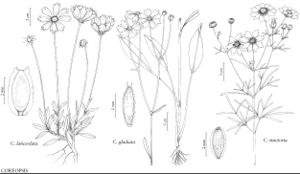Coreopsis tinctoria
J. Acad. Nat. Sci. Philadelphia 2: 114. 1821.
Annuals, (10–)30–70(–150+) cm. Leaves: proximal blades usually 1(–3)-pinnate, terminal lobes lance-ovate to oblanceolate, 10–60 × 5–25 mm; cauline blades usually 1–2(–3)-pinnate, rarely simple, simple blades or terminal lobes lance-linear to linear or filiform, 10–45 × 0.5–2(–5+) mm. Peduncles 1–5(–15+) cm. Calyculi of deltate-lanceolate bractlets 1–3+ mm. Phyllaries ± lance-oblong to lance-ovate, 4–7(–9) mm. Ray laminae usually yellow with red-brown blotch, sometimes red-brown in proximal 1/3–9/10 and distally yellow, rarely yellow throughout, 12–18+ mm. Disc corollas 2.5–3+ mm. Cypselae 1.5–3(–4+) mm, wings 0 or 0.1–0.7+ mm wide; pappi 0, or of 1–2 cusps or subulate scales 0.1–1+ mm. 2n = 24 (+ 0–2 Bs).
Phenology: Flowering year round, mostly Jun–Aug.
Habitat: Moist, sandy or clay soils, sometimes alkaline flats, prairies, ditches, disturbed places
Elevation: (0–)20–1500(–2000) m
Distribution

Alta., B.C., Man., Ont., Que., Sask., Ala., Ariz., Ark., Calif., Colo., Conn., Del., D.C., Fla., Ga., Idaho, Ill., Ind., Iowa, Kans., Ky., La., Maine, Md., Mass., Mich., Minn., Miss., Mo., Mont., Nebr., N.H., N.J., N.Mex., N.Y., N.C., N.Dak., Ohio, Okla., Oreg., Pa., R.I., S.C., S.Dak., Tenn., Tex., Vt., Va., Wash., W.Va., Wis., Wyo., Mexico (Coahuila, Nuevo León, Tamaulipas).
Discussion
Coreopsis tinctoria is widely grown in public and residential gardens, and commercially (for cut flowers), and has become widely established in the flora area.
As here circumscribed, Coreopsis tinctoria includes plants that others (without agreement among themselves) have treated as distinct species or infraspecific taxa: C. atkinsoniana (plants mostly 50–150+ cm, seldom branched from bases; cypselae 2.5–3 mm, “narrowly” winged; pappi 0.1–0.2 mm; mostly Idaho, Montana, Oregon, Washington), C. cardaminifolia (plants mostly 20–50 cm, seldom branched at bases; cypselae 2 mm, “narrowly to widely” winged; pappi 0 or 0.1–0.2 mm; mostly Arkansas, Kansas, Louisiana, Nebraska, Oklahoma, Texas), and C. tinctoria var. similis (plants mostly 10–30 cm, usually branched from bases; cypselae 2–3 mm, “widely” winged; pappi 0.2–1 mm; Texas and Mexico).
Selected References
None.
